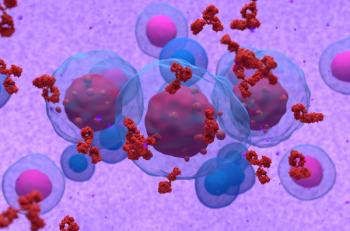
Genetic Predictors of Progressive Multifocal Leukoencephalopathy

The implementation of genetic testing for patients prescribed medications associated with progressive multifocal leukoencephalopathy is likely to improve safety outcomes.
What is progressive multifocal leukoencephalopathy (PML)?
PML is a central nervous system (CNS) infection caused by the John Cunningham virus (JCV).1 JCV infection is very common and can be passed on through contaminated surfaces, food, water, and person-to-person contact.2
By some estimates, up to ~80% of the world population will become seropositive during their lifetime.2,3 In most cases infection is latent and asymptomatic.
PML develops when the JC virus becomes reactivated during immunosuppression, which can occur due to various conditions, including HIV/AIDS, hematological malignancies, autoimmune disorders, and organ transplants. Reactivation can also occur in iatrogenic immunosuppression.
PML causes demyelination of white and gray matter, leading to CNS disturbances, including altered mental status, ataxia, visual impairment, aphasia, and seizures.3 Treatment typically includes restoring the patient’s immune response by stopping any immunosuppressive drugs, initiating antiretroviral therapy if caused by HIV infection, and offering supportive treatment.4
Why is identifying at-risk patients important?
Once PML develops, prognosis is poor, with life expectancy as low as 3 months in some cases.4 Survivors are left with neurological disabilities as remyelination does not occur.
Currently, more than 3 dozen drugs exist that include a PML warning in their prescribing information, including natalizumab, fingolimod, efalizumab, and anti-CD20 antibodies, such as rituximab.1 With many potentially lifesaving drugs being linked to PML, prevention strategies are critical. The development of PML risk biomarkers emerges as an area of high unmet need.
What is the role of genetic biomarkers?
A recent study published in December 2022 by Hatchwell et al., which investigated 336 PML cases, identified 4 variants found in immune system genes that strongly correlate with the risk of developing PML: C8B, FCN2, STXBP2, and LY9.1 Despite being rare within the general population (allele frequencies of < 0.5%), these variants are predicted to be detrimental.
The study found that 10.9% of drug-exposed PML cases had at least 1 of these variants, compared to only 1.9% in drug-exposed controls. Researchers found that for every 355 patients genotyped, 1 PML case would be avoided.
Based on these data, the investigators predict that prophylactic genetic testing would prevent 9.4% of drug-induced PML cases. Number needed to treat (NNT) was 6, meaning that 1 PML case can be avoided per every 6 patients who carry 1 of the 4 variants.
How would this compare to other examples of genetic testing?
Genetic testing for the 4 identified variants to prevent PML would have greater clinical utility than testing for BRCA genes to assess breast cancer risk, or testing for HLA-B*15:02 to assess Stevens-Johnson syndrome/toxic epidermal necrolysis (SJS/TEN) risk with carbamazepine, as shown in the below figures adapted from Hatchwell et al.1
The proposed PML test had a higher odds ratio (OR) and diagnostic (Dx) yield than BRCA testing, meaning that the 4 identified variants have a stronger association with PML than the BRCA genes do with breast cancer, and that more PML cases had at least 1 of the variants present than breast cancer cases did BRCA1 or BRCA2.
The proposed PML test also had a higher positive predictive value (PPV) than the required SJS/TEN HLA-B*15:02 test for carbamazepine, indicating that there is a higher chance that a patient with at least 1 of the 4 identified variants will develop PML than a patient who is HLA-B*15:02 positive will develop SJS/TEN while taking carbamazepine.
The lower NNT value for the proposed test also shows that fewer patients would need to be tested to prevent 1 case of PML than to prevent 1 case of SJS/TEN. The authors also note that the mortality rates of SJS, TEN, and PML are 1%-5%, 25%-35%, and 23%-65%, respectively.
What now?
Future directions in research include investigating whether these findings can be applied to a broader ethnic population, as this study included only patients with European or African ancestry.1 Additionally, drug-specific association was only studied for natalizumab as this was the largest subgroup.
Therefore, investigating other drugs associated with PML may also be beneficial. Considering the strong associations between the 4 identified genetic variants and PML in conjunction with the high mortality rates, the implementation of genetic testing for patients prescribed medications associated with PML is likely to improve safety outcomes and pave the way for additional genetic research focused on preventing medication-related adverse reactions.
About the Author
Ekaterina Pytel, PharmD Candidate, University of Minnesota, Class of 2023.
Preceptor: Serena Mitaly, PharmD, PGY2 Pharmacogenomics Pharmacy Resident, Mayo Clinic- Rochester.
References
- Hatchwell E, Smith EB 3rd, Jalilzadeh S, et al. Progressive multifocal leukoencephalopathy genetic risk variants for pharmacovigilance of immunosuppressant therapies. Front Neurol. 2022;13:1016377. Published 2022 Dec 14. doi:10.3389/fneur.2022.1016377
- Cortese I, Reich DS, Nath A. Progressive multifocal leukoencephalopathy and the spectrum of JC virus-related disease. Nat Rev Neurol. 2021;17(1):37-51. doi:10.1038/s41582-020-00427-y
- Koralnik IJ. Progressive multifocal leukoencephalopathy (PML): Treatment and prognosis. Post TW, ed. UpToDate. Waltham, MA: UpToDate Inc. http://www.uptodate.com. (Accessed on January 12, 2023).
- Koralnik IJ. Progressive multifocal leukoencephalopathy (PML): Epidemiology, clinical manifestations, and diagnosis. Post TW, ed. UpToDate. Waltham, MA: UpToDate Inc. http://www.uptodate.com. (Accessed on January 12, 2023).
Newsletter
Stay informed on drug updates, treatment guidelines, and pharmacy practice trends—subscribe to Pharmacy Times for weekly clinical insights.
















































































































































































































